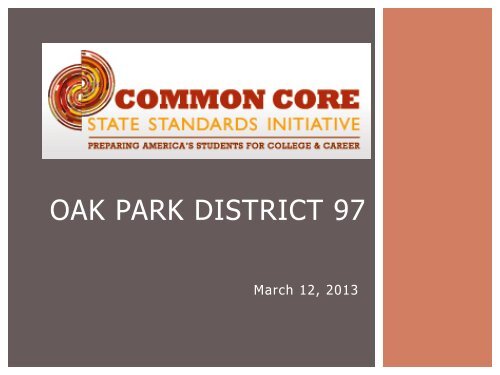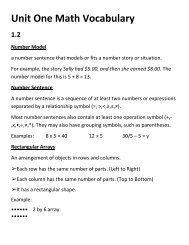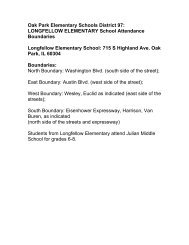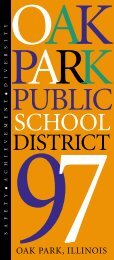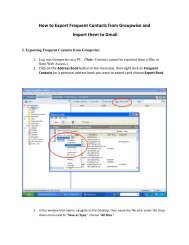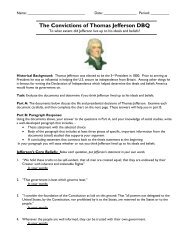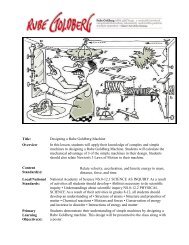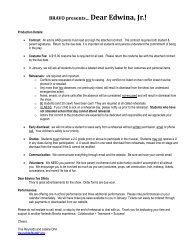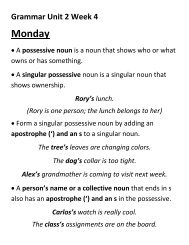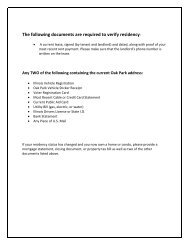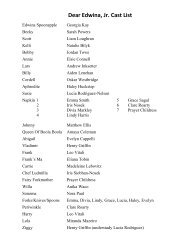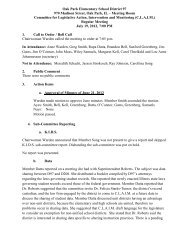Common Core State Standards - Oak Park Elementary School ...
Common Core State Standards - Oak Park Elementary School ...
Common Core State Standards - Oak Park Elementary School ...
You also want an ePaper? Increase the reach of your titles
YUMPU automatically turns print PDFs into web optimized ePapers that Google loves.
OAK PARK DISTRICT 97<br />
March 12, 2013
CCSS…. WHY NOW?<br />
The <strong>Common</strong> <strong>Core</strong> <strong>State</strong> <strong>Standards</strong> Initiative<br />
is a state-led effort coordinated by the National<br />
Governors Association (NGA) and the Council of<br />
Chief <strong>State</strong> <strong>School</strong> Officers (CCSSO).<br />
¡ Disparate standards across states<br />
¡ Student mobility<br />
¡ Global competition<br />
¡ Today’s jobs require different skills
Why is this important for<br />
students, teachers, and parents?<br />
¡ Prepares students with the knowledge<br />
and skills they need to succeed in<br />
college and work<br />
¡ Ensures consistent expectations<br />
regardless of a student’s zip code<br />
¡ Provides educators, parents, and<br />
students with clear, focused guideposts
The <strong>Standards</strong> are……<br />
¡ Fewer, clearer, and higher, to best drive<br />
effective policy and practice;<br />
¡ Aligned with college and work expectations, so<br />
that all students are prepared for success upon<br />
graduating from high school;<br />
¡ Inclusive of rigorous content and application of<br />
knowledge through high-order skills, so that all<br />
students are prepared for the 21 st century;<br />
¡ Internationally benchmarked, so that all<br />
students are prepared for succeeding in our global<br />
economy and society; and<br />
¡ Research and evidence-based.
English Language Arts (ELA) <strong>Standards</strong><br />
College and Career Readiness (CCR) <strong>Standards</strong><br />
§ Overarching standards<br />
Grade-Level <strong>Standards</strong> in English Language Arts<br />
§ K-8, grade-by-grade<br />
§ Four strands: Reading, Writing, Speaking and<br />
Listening, and Language<br />
<strong>Standards</strong> for Literacy in Social Studies and Science<br />
§ <strong>Standards</strong> are embedded at grades K-5<br />
§ Content-specific literacy standards are provided<br />
for grades 6-8, 9-10, and 11-12
Research-Based<br />
The <strong>Common</strong> <strong>Core</strong> is in part a response to the<br />
steady decline in the complexity of texts<br />
over the last 50 years in US schools.<br />
Chall & Colleagues<br />
Harvard University
ELA <strong>Standards</strong><br />
¡ All students must be able to<br />
comprehend texts of steadily<br />
increasing complexity as they<br />
progress through school.<br />
¡ The complexity of what students<br />
read matters.
Literature/Informational Text<br />
Grade<br />
Level<br />
Literature<br />
Informational Text<br />
4 th 50% 50%<br />
8th 45% 55%<br />
12th 30% 70%
Six Shifts in the ELA <strong>Standards</strong><br />
¡ Read as much non-fiction as fiction<br />
¡ Help your child learn about the world by<br />
reading<br />
¡ Read more challenging material<br />
¡ Discuss reading and ask for evidence from<br />
your child from the text<br />
¡ Write non-fiction<br />
¡ Increase use of “academic” vocabulary
Mathematics<br />
Focus strongly where the <strong>Standards</strong><br />
focus<br />
Coherence: Think across grades, and<br />
link to major topics within grades<br />
Rigor: Require fluency, application,<br />
and deep understanding
Mathematics <strong>Standards</strong><br />
<strong>Standards</strong> for Mathematical Content<br />
§ K-8 grade-by-grade standards organized by<br />
domain<br />
<strong>Standards</strong> for Mathematical Practice<br />
§ Describe mathematical “habits of mind”<br />
§ Offer standards for mathematical proficiency:<br />
reasoning, problem solving, modeling, decision<br />
making, and engagement<br />
§ Connect with content standards in each grade
Eight <strong>Standards</strong><br />
for Mathematical Practice<br />
1. Make sense of<br />
problems and persevere<br />
in solving them.<br />
2. Reason abstractly and<br />
quantitatively.<br />
3. Construct viable<br />
arguments and critique<br />
the reasoning of others.<br />
4. Model with<br />
mathematics.<br />
5. Use appropriate tools<br />
strategically.<br />
6. Attend to precision.<br />
7. Look for and make use<br />
of structure.<br />
8. Look for and express<br />
regularity in repeated<br />
reasoning.
Sample CCSS 4 th Grade Math Problem
Six Shifts in the Math <strong>Standards</strong><br />
¡ Focus – learn about fewer, key topics<br />
¡ Keep building on learning year after<br />
year<br />
¡ Developing speed and accuracy<br />
¡ Understand why math works and be<br />
able to prove it<br />
¡ Apply math in real world situations<br />
¡ Think fast and solve problems
The Imperative<br />
¡ Our new <strong>Common</strong> <strong>Core</strong> <strong>Standards</strong> will<br />
challenge us to move beyond recall of<br />
facts.<br />
¡ We will be challenged to assess<br />
student learning in more complex and<br />
multi-dimensional ways.<br />
¡ We will also be challenged to infuse<br />
more cognitive complexity into the<br />
knowledge-acquisition process.<br />
(Conley, 2011)
The Partnership for Assessment of<br />
Readiness for College and Careers:<br />
§ Made up of 22 states<br />
§ Charged with developing high-quality<br />
math and English language arts tests for<br />
grades 3–11<br />
§ Computer-based and linked to what students<br />
need to know for college and careers<br />
§ Implementation in 2014–15 school year
PARCC Priorities<br />
1. Determine whether students are college and<br />
career ready or on track<br />
17<br />
2. Connect to the <strong>Common</strong> <strong>Core</strong> <strong>State</strong> <strong>Standards</strong><br />
3. Measure the full range of student<br />
performance, including that of high- and lowachieving<br />
students<br />
4. Provide educators data throughout the year to<br />
inform instruction<br />
5. Create innovative 21st century, technologybased<br />
assessments<br />
6. Be affordable and sustainable
How will PARCC be different?<br />
Students: Will know if they are on track<br />
to graduate ready for college/careers<br />
Teachers: Will have access to timely data to<br />
guide learning and instruction<br />
Parents: Will have clear and timely<br />
information about student progress<br />
<strong>State</strong>s: Will have valid results that are<br />
comparable across borders
COMMON CORE<br />
Irony: It is not about being<br />
“common” or “ordinary”
It is about….<br />
Being EXTRAORDINARY!
For more information<br />
¡ www.op97.org<br />
§ National PTA <strong>Common</strong> <strong>Core</strong> Parent Guides<br />
§ Parent Roadmaps from the Council of Great City<br />
<strong>School</strong>s<br />
¡ <strong>Common</strong> <strong>Core</strong> <strong>State</strong> <strong>Standards</strong><br />
§ http://www.corestandards.org/<br />
¡ PARCC - Partnership for Readiness for College and<br />
Careers<br />
§ http://www.parcconline.org


